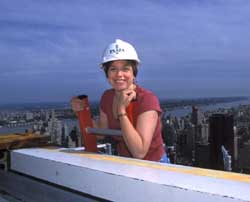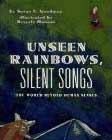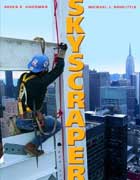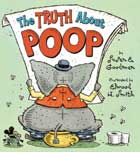Featured Author: Susan Goodman

We're devoting this newsletter to works of nonfiction and, in particular, to books written by Susan E. Goodman.
Although nonfiction books are often the first choice of readers of all ages, educators tend to assume that such books are all pretty much of a kind, differing only in level of reading difficulty. Even though most standardized tests demand that students write an expository essay on a given subject, we tend to ignore one of the best sources of expository writing that can serve as examples for young learners: well-written informational books. The skills needed for reading and writing nonfiction are not the same as those for works of fiction. When reading nonfiction, we tend to browse first and read later if at all. We sometimes do that reading out of order, scanning through unwanted information. We look at photographs and read captions. While there are many nonfiction books available for children, many are not particularly well-written and do not open doors to new areas of interest for young readers as Susan Goodman's books do. Hence, our choice for this newsletter.
Some words to describe Susan Goodman are: funny, curious, vivacious, irreverent, challenging, ambitious, friendly, articulate, and full of wonder. Those same adjectives can be applied to her books.
Susan Goodman feels that good informational books can help children become aware that the world is an exciting place. She is inspired by the possibility that something she writes might be a child's first introduction to a subject. She wants to convey the sense of wonder that she has in the subjects she explores. She breathes life into her subjects and finds ways to make the facts exciting. Her informational picture books are accessible to readers from kindergarten on up, largely because of her choice of photographs and materials for exploration.
Susan was born in Detroit, Michigan. Her father owned a clothing store in Milford, Michigan, and her mother was a high school English teacher. As a child Susan says she was a good student, but was not particularly adept at or concerned with writing. In her senior year of high school this changed when she handed in a paper on Hamlet expecting her usual good grade. To her dismay, she received a D-. She went to speak to the teacher who said it was really a very poor paper that deserved nothing better. If Susan was willing, the teacher said, she would help her improve it. In the process of getting that D- paper up to an A, Susan learned that you have to have something to say when you write.
Susan worked for her father in the store through high school. Part way through college, she spent a year studying cooking at the Cordon Bleu in Paris. Discarding that possible career, she got an M.A. in counseling. Her first job after graduation was as a social worker in the Boston area. Unhappy with that choice too, she started writing food articles for newspapers and magazines, moving from that topic into writing articles on various other subjects about which she had either knowledge or curiosity, eventually publishing over seven hundred such articles.

When she reached her saturation point with writing for magazines, Susan Goodman turned to children's books. The result was Unseen Rainbows, Silent Songs: The World Beyond Human Senses (Atheneum, 1995 ISBN 0689318928) a book about the things animals perceive that human beings cannot.
Usually, when Susan gets an idea for a book, she contacts editors to find someone interested in the concept. Sometimes these ideas hatch from newspaper articles, roaming the Internet, or conversations with friends. She likes catching on to something that seems complicated and coming up with ways to explain it to children. Sometimes editors with whom she has previously worked approach her with an idea for a book. Either way, the fun and hard work begin. Often her research involves travel and experiences that are thrilling and exciting.
Her research has led her to such experiences as: staying in an underwater hotel, standing on the top of the Arctic icecap in Greenland, floating high above Rhode Island in a hot air balloon, traveling deep in the rainforest of Peru. She has swum with the dolphins and gone to Space Camp to try the simulators astronauts used for their own training.
For one of her most recent books, Skyscraper (Knopf, 2004 ISBN 0375813098. Order Info.), Sue found herself perched on a steel girder fifty floors in the air over Manhattan. When a steel worker asked if she was frightened, she admitted that she was a little nervous. He asked her if she was this frightened when she was at the fifth floor level. When she said she hadn't been, he said, "It doesn't matter whether you're on the fiftieth floor or the fifth floor; if you fall, they still have to scrape you up with a shovel." Somehow, she found that reassuring.

When I asked if any of these adventures had frightened her, she said that the trepidation usually comes before the trip. Once there, she is reassured by the competence of those in charge. She says, "If you are with people who know what they're doing, and you have a wary respect for the environment you're in, you'll be all right."
She shares some of these adventures with children in school visits. The rest of us must learn about them through her books.
Increasingly, standardized testing requires that students do expository writing on a given topic. Before examining some of Susan Goodman's individual books with students, take some time to examine the array of her books. Consider her various organizational systems. In Skyscraper she uses a chronological approach. Would that work with all her books? Why or why not? If the students' study skills include standard outlining procedures, does any given book of Susan Goodman's fit that organization with main topic and its various subdivisions in a linear manner? Would webbing work better for the organization of a Goodman book? What other approaches or systems does she use? What does that choice do to your interest or lack of interest in the subject?
Together with the students, consider the writing of a nonfiction picture book as a problem solving activity. How would or could Ms. Goodman have gone about her research? Could she have gotten it all from the Internet? How did she know which facts to include in order to make the information interesting? Given what students know about any of her topics, what information would they have included that she did not?
Evaluate the books as reference sources. If you were asked to do a report on this subject, would this Goodman book be a good place to start? What information is unique to this particular book? Which information is available elsewhere? Which of the facts in this book deserve further exploration? Which facts make you want to know more? How does this book differ from an article in an encyclopedia?
Now to the specifics: her latest books are indicative of the range of subjects she tackles. Three of the five books about to be released were made available to us.
The before-mentioned Skyscraper, photographed by Michael J. Doolittle, follows the construction of the Random House Building in New York City from conception to completion. The photographs make it interesting even for non-readers, and the reading level is such that a second grader should be able to read it with little help. The book is full of information about the people, tasks and materials involved. It would be of interest up as high as middle school.
Each job in the building construction is treated with great respect. "Some artists paint and draw. Architects are artists who sculpt the city." Many of Susan's images are unforgettable. When describing the digging of the hole for the building, she says, "In one corner, workers hit bedrock too soon; the basement needs to be deeper. They use the world's biggest hammer to punch through. Each blow is so hard that it makes waves in toilets a block away."
The statistics in the book provide material for math and physics activities: 2000 loads of dirt are removed from a hole; the basement hole is forty feet deep and a city block wide; filling it with water from a garden hose would take four years, etc.
Physics, geology, engineering, economics, architecture, and city planning are just a few of the subjects approached in this book. So math, social studies, physical science and art are involved even before you finish the book. Building tall block structures and figuring out which ones are most stable would be an interesting follow-up. Try looking at the tallest structures in your area and deciding what effect their presence has on the economy and environment. Where did the people who designed and built that structure come from and where did they go when it was finished? Is the building more or less elaborate than those built before or since? What modern technologies were not then available?
David Macaulay's book, Unbuilding (Houghton Mifflin, 1987 ISBN 0395454255. Order Info.), might make an interesting connection here as would any books that deal with life in the city such as From the Mixed-Up Files of Mrs. Basil E. Frankweiler by E. L. Konigsburg (Aladdin, 1998 ISBN 0689711816. Order Info.) or My New York by Kathy Jakobsen (Little Brown, 2003 ISBN 0316927112. Order Info.). Step into poetry with Rachel Field's poem "Skyscraper," available in many anthologies. Another of Susan Goodman's new releases: On This Spot would also be a logical extension of Skyscraper.

In On This Spot: An Expedition Back Through Time, illustrated by Lee Christiansen (Greenwillow, 2004 ISBN 0688169147. Order Info.), Susan takes one spot, in this case a place in New York City, and follows it back through time. That concept is not unique: several other authors have done the same, following a place back two or three hundred years to its natural state, but Goodman goes much farther. Her steps backward are big ones: 175 years ago, 400 years ago, thousands and then millions of years ago. So we go from bustling metropolis to prehistoric life forms in the pages of a picture book.
It's a logical step to go from this book to your own spots. If you want to do a class investigation, choose a spot like your school or a landmark in your area and follow it back in time as Susan Goodman did. You can choose to make major leaps backward in time or take smaller steps, going back by decades. If you want individual research efforts, encourage the students to go backward from their home sites or make larger backward leaps by choosing a very different area somewhere in the world. You may start with local histories or a visit to the city clerk's office. Map studies are a must and topographical maps supplied by the US Interior Department may be a source of needed information. A class field trip to the nearest science museum could help. The U.S Geological Survey has a department on their website (www.usgs.gov) where students can get answers to their email questions. Presentation of the results of the research can take many forms including, of course, a picture book.
Other books that connect well to On This Spot are A River Ran Wild by Lynne Cherry (Gulliver, 1997 ISBN 0152005420. Order Info.) and Crescent Dragonwagon's Home Place (Simon & Schuster, 1990 ISBN 0027331903. Order Info.).

The title of Susan E. Goodman's third release this year is an attention-getter: The Truth About Poop, illustrated by Elwood H. Smith (Viking, 2004 ISBN 0670036749. Order Info.). The title is self-explanatory, and don't sniff and turn away from this one. (Pardon the pun.) It makes for fascinating reading even for the most fastidious reader. Although her touch is light, and it's impossible to read the book without grinning, Susan never goes for the cheap shot. She chuckles without smirking. Chapter headings include: Useful Poop, History of the Toilet Parts 1 and 2, Dung Dispatch, and Poop Power. Having trouble getting third or fourth graders to read a book? Put this one on the table and see how long it takes before a group of kids (probably boys) are gathered around absorbing scientific information.
Good follow-up activities from The Truth About Poop might be investigating owl pellets. Workman Publishing has just produced a kit called Owl Puke by Jane Hammerslough which includes a real owl pellet. Owl pellets can also be purchased online.
A field trip with kids armed with magnifying glasses on a poop search need not go farther than the nearest tree this time of year where insect droppings are bound to be found. Dig deeper literally and kids can research your area's sewage system and find out how much environmental damage it creates.
Goodman has done a few book series. One such series, "The Ultimate Field Trip," follows students on various learning adventures. The titles are self-explanatory: Ultimate Field Trip #1: Adventures in the Amazon Rain Forest (0606163247. Order Info.); Ultimate Field Trip #2: Digging into Southwest Archaeology (9991585028. Order Info.); Ultimate Field Trip #3: Wading into Marine Biology (0689838905. Order Info.); Ultimate Field Trip #4: A Week in the 1800s (0689830459. Order Info.); Ultimate Field Trip #5: Blasting Off to Space Academy (0689848633. Order Info.). All of these have photographs by Michael J. Doolittle and all are published by Aladdin.
Other books by Susan E. Goodman include:
Nature Did It First (Millbrook, 2003 ISBN 0761324135. Order Info.), a series of photographic puzzles for young children.
Claws, Coats, and Camouflage: The Ways Animals Fit Into Their World (Millbrook, 2001 ISBN 0761318658. Order Info.), which explores various survival adaptations.
Seeds, Stems and Stamens: The Ways Plants Fit Into Their World (Millbrook, 2001 ISBN 0761318747. Order Info.), a similar book on plant adaptation.
A series called Brave Kids: True Stories from America's Past. These include Hazelle Boxberg (Aladdin, 2004 ISBN 0689849826. Order Info.), Cora Frear (Aladdin, 2002 ISBN 0689843291. Order Info.), and Robert Henry Hendershot (Aladdin, 2003 ISBN 068984980X. Order Info.). These are slightly fictionalized biographies (conversation and some details invented) accessible for kids from third grade up. The last chapter of each book discusses which elements of the story are true and gives added historical background.
The list goes on as this prolific author opens up subjects for young readers. Taking a glance at one is almost impossible. Each book by this woman of infinite variety is an invitation to learning.
![]()
Related Areas of Carol Hurst's Children's Literature Site
- Author studies: Articles on other authors.
- Author Studies in the classroom. General books and activities for any author.
Related Areas on Other Web Sites
- Susan Goodman's Website:
http://www.susangoodmanbooks.com
Advertisement:
Advertisement:
Advertisement:

